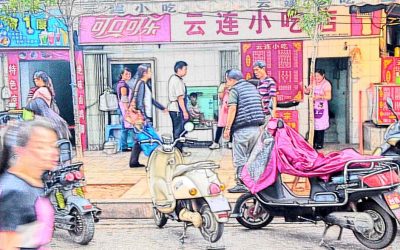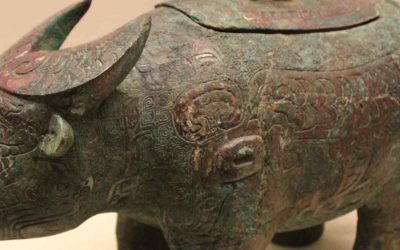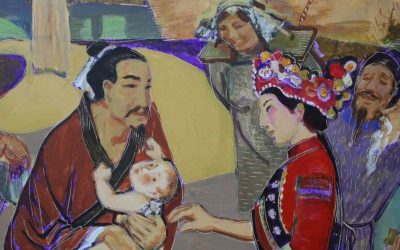The Bull that Shaped the World and Other Sacred Bovines among the Bulang Minority
The Bulang people (布朗族), an Austroasiatic ethnic group primarily inhabiting Yunnan’s tea-growing highlands, revere the ox as a sacred being intertwined with creation, agriculture, and spiritual power. The ox appears in their myths, agricultural rituals, festivals, and social customs, representing strength, prosperity, and spiritual connection. The Bulang’s ox traditions are uniquely tied to tea cultivation, cosmic order, and ancestral blessings.
In the Beginning, There Was the Ox
Among some Bulang, the ox is considered a sacred animal that helped in creation or provided sustenance to early humans. The creation myth Gumiye tells of a big ox that created everything that exists in this world. After the creation was completed, he used his four legs to keep the heaven stable. In some versions, the ox plowed the earth with its horns, creating mountains and valleys, its sweat formed rivers, and its breath brought wind, allowing life to flourish.
The Ox and the Beginning of Agriculture
There are also tales that link the ox to the origins of agriculture. One legend tells of a heavenly ox that descended to earth carrying the first grains of rice or millet in its mouth (or dung). In another one, a Bulang ancestor followed the ox and discovered that where it rested, crops sprouted. In some others, the ox then taught people how to plow and sow, linking it to the origin of farming, or a divine or heroic ox teaches the Bulang people farming techniques, emphasizing the animal’s role in their transition from hunting to agriculture.
These myths explain why the ox has a central role in some rituals related to the traditionally swidden (slash-and-burn) agriculture. Its presence is especially important in the Plowing Ceremonies, performed before planting, when rituals are performed to honor the ox; and in Thanksgiving Festivals, after harvest, when Bulang communities express gratitude to the ox for its work. They decorate cattle, feed them special foods, and perform dances. In some places, the Ox Dance (牛舞) imitates ox movements, symbolizing fertility and strength.
The Ox and the Origin of Tea
Other myths relate it to tea. They tell of a demon (or drought spirit) that devoured crops until a sacred ox challenged it. The ox fought the demon for days, finally trampling it into the earth. Where the demon’s blood fell, the first tea plants grew. The ox then collapsed, and its body became a mountain that protected the village. Other versions state that after the battle, the people discovered that where an ox’s blood fell, the first tea plants appeared. The transformation of blood into tea is unique to the Bulang. Some of their tea fields are protected by oxen heads, and in some villages in Mengsong (勐宋) district, they perform ox sacrifices during tea-harvesting ceremonies, recalling the myth.
Spiritual Role of the Ox
The ox also has a sacrificial and spiritual role. Due to its ability to communicate with heavenly deities, it is sacrificed to honor ancestors or deities, believing that it will carry the prayers to the spirit world. Oxen are also central to other festivals. In New Year and Harvest Festivals, the ox is sometimes paraded or decorated. In some villages, an ox made of dough or straw is offered to ancestors, mirroring the cosmic ox’s sacrifice. In Xishuangbanna, the «Gangyong» (岗永) Festival includes a ritual ox sacrifice to pray for rain/harvest, tied to the demon-slaying myth. In Lincang, they have an Ox King Festival, held on the 8th day of the 4th lunar month (similar to Han Chinese Ox King festivals), which focuses on thanking oxen for labor—feeding them sticky rice and let them rest the whole day.
Ox bones are perceived as full of magical power, and they are used sometimes in traditional divination. There are no studies to ascertain if this was an independent development or could be related to the Oracle Bone divination practiced in China more than 3,000 years ago.
Conclusion
The ox in Bulang culture is more than just a farm animal—it embodies labor, sustenance, and spiritual connection. Its presence in myths, rituals, and daily life underscores its role as a symbol of resilience, prosperity, and communal harmony. Its economic and religious value makes the ox second only to people in Bulang symbolic thought. Owning cattle was historically a sign of prosperity among them, and oxen were used in trade or as bride prices in marriages.
About me: I have spent 30 years in China, much of the time traveling and studying this country’s culture. My most popular research focuses on Chinese characters (Chinese Characters: An Easy Learning Method Based on Their Etymology and Evolution), Matriarchy in China (there is a book with this title), and minority cultures (The Naxi of Southwest China). In my travels, I have specialized in Yunnan, Tibet, the Silk Road, and other lesser-known places. Feel free to write to me if you’re planning a trip to China. The agency I collaborate with offers excellent service at an unbeatable price. You’ll find my email below.
Last posts
An oriental interpretation of dreams
An oriental interpretation of dreams Last week, in a book about the Hani minority in the remote Jinping region, one of the authors devoted part of his article on divination to dream interpretation among the Hani. I translated it, added some comments and published it...
What does it mean to dream of a cow in China? We tell you here
What does it mean to dream of a cow in China? We tell you here In the last few days I have stumbled upon several documents dealing with dreams in China, and some with certain fragments explaining, in particular, the meaning of dreaming about a cow. One of the most...
The Interpretation of the Dreams among the Hani
The Interpretation of the Dreams among the Hani As a general rule dream interpretation in China has followed a symbolic line, attributing to the memories of experiences lived during the dream a value related, sometimes not so clearly in a first analysis, to the values...
Temple to the Mother of the Dragon of the Bai
Temple to the Mother of the Dragon of the Bai Everyone who visits the ancient city of Dali goes to see the famous Three Pagodas, as it is one of the most famous monuments of the city and all of Yunnan, but very few know that right in the village next door, just 100...
Unconventional languages used by the Jinuo
Unconventional languages used by the Jinuo Not having a writing system, the Jino developed several systems of signs that covered communication in different situations: from the wooden gates in the mountain paths that warn of danger, to the daliu to expel demons, the...
The Temple of Shen’an: Exemplary Writer and Traveler in Ming China
The Temple of Shen'an: Exemplary Writer and Traveler in Ming China Almost at the entrance to Kunming's famous West Mountains there is a small temple that goes unnoticed by most travelers. It certainly cannot compete in importance, beauty or decoration with the...










